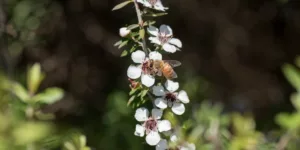New Zealand is an amazing island country lost somewhere in the Southwest Pacific Ocean. The closest neighbors are located almost one and a half thousand kilometers away. There are no large-scale industrial projects here, which contributes to the preservation of pristine pure air.
Care for ecology and preservation of a unique environment is one of the main priorities in the development of the country. Today, New Zealand is considered the cleanest country on our planet, and it sets a great example of the gentle treatment of nature.
The Unique New Zealand Honey
Natural isolation of the country contributes to the preservation of pure authentic vegetation, which ensures healthy cattle breeding and, more importantly, beekeeping. Local bees have a strong immune system; they do not need supplemental, filled-with-chemicals food intended to fight or prevent bee diseases.
As a result, bees do not transfer chemicals to the plants they pollinate, thus leaving the fauna as pristine as it used to be many centuries ago. Feeding of bees with sucrose and syrups to increase the yield of honey products, honey or royal jelly is absolutely out of the question. The government took on the responsibility for adhering to the regulations by creating an effective certification system for all beekeeping products.
Today, the honey produced on the territory of New Zealand represents an absolutely natural organic high-quality product. If we add uniqueness of the honey plants of New Zealand, we can easily claim that the honey produced by the New Zealand bees is one of a kind. Honey is known as a valuable food product which has a pleasant taste and plenty of special properties that have health benefits for a human body.
There are differences between types of honey plants from which the nectar was collected. It affects some useful properties of honey. They are known to both beekeepers and honey lovers.
Honey is considered especially valuable for a favorable effect it has on the human immune system. That’s why professional beekeepers try not to mix different types of nectar in a honeycomb. Is there a natural product – amid this huge variety of products – that has the most benefits?
One of the most biologically active varieties of honey is Manuka honey. The best brands that produce this unique product are reviewed in the DiligentChef project. The author of the article also warns his readers against honey that does not have UMF-certification. But let’s talk about all of that step by step.
What is so Special about Manuka Honey?
The first Europeans who came to the islands of New Zealand during colonization noticed an excellent state of health of the Maori Indians who had migrated to this land in the IX century. While studying folk medicine of Aborigines, the scientists discovered a unique local plant – Manuka; it is classified in biology as Leptospermum Scoparium of the Myrtle family.
This tree-like shrub can grow as high as four meters, and it is considered a sacred plant that gives life, health, and longevity and helps to maintain good spirits. The leaves and branches of the plant are covered with silverish fluff; the dried bark of the old branches exfoliates. The flowers of the plant are large: up to 2 cm in diameter; they are of white or pale-pink color, and they are usually located at the sinus of the leaf or at the tips of the branches. The blooming time is spring and summer – according to the southern hemisphere season calendar (from September to February).
Manuka plant is not very picky about the soil it grows in; it grows everywhere throughout the islands: from lowlands to the subalpine zone. For normal development, it requires a certain amount of moisture and sunlight, which is why you can find these shrubs growing on the river banks, open slopes, and outskirts of forests.
In the language of the Maoris, the word “manuka” means enthusiasm and high spirit, positive state of mind and well-meaning attitude. According to the legend, James Cook and his comrades used to prepare a tea drink from Manuka leaves.
New Zealand parrots use leaves and bark of Manuka to clean their feathers: they gnaw them and dissolve them in their saliva, and then they mix the substance with the secretions of the preen gland and apply it to their feathering. This fact has drawn the attention of the scientists, and they concluded that Manuka helps to fight against various parasites and bacteria, and one of them is Staphylococcus aureus. According to medical scientists, more than 20% of today’s mankind hosts these bacteria.
All these factors give a reason to believe that honey obtained from the nectar of Manuka, is a highly effective natural healing remedy. The level of concentration and the degree of its activity are determined by different factors: the nature of the soil and the humidity level, the weather and the ultraviolet irradiation level, the intensity of color and the time frame for collecting the nectar.
To ensure high quality of the product and protect it against profiteering, New Zealand beekeepers together with partners from Australia have concluded a contract aimed at mandatory certification and licensing of Manuka beekeeping products. It means that only those beekeepers who meet certain criteria can be issued a license to produce and sell Manuka products. Here are the criteria:
- keeping only healthy bees;
- not using any supplemental food;
- hives should be located in the areas with a predominant growth of Manuka shrubs;
- honey can be produced only from Manuka nectar without using any other honey-making plants as additives.
The latter is considered important because some honey-making plants can cause an allergic reaction.
Special Properties of Manuka Honey
During the study of the unique properties of Manuka shrubs, scientists were able to detect a special ingredient – a substance that has a direct destructive impact on staphylococcal cells. This active ingredient is called Methylglyoxal (MGO).
Penetrating into the affected cell, Methylglyoxal starts releasing hydrogen peroxide in a concentration that is not sufficient to damage the cell, but sufficient to vaporize the liquid inside of it, thus depriving the bacteria of food and destroying them.
Once the liquid balance is restored, the cell returns to its normal state. The strength of the antibacterial effect of honey is determined by the MGO concentration: in Manuka, it varies between 30-1000 mg/kg.
This index is not one-dimensional: it is a whole complex of factors that characterize the medicinal and immune activity of Manuka honey. The higher the index, the greater the antibacterial, antifungal, and anti-inflammatory properties of this honey.
Indications for use of Manuka honey
Manuka honey contributes to a speedy recovery in many diseases. Here is a list of diseases that can be treated with Manuka:
Internal:
- throat inflammation;
- gum inflammation;
- diseases of the stomach and intestinal problems: ulcers, acid belching, heartburn, diarrhea and constipation, worms, irritated bowel syndrome;
- arthritis;
- fatigue and aches and pains of unclear nature.
External:
- insect bites;
- eczema and dermatitis of various nature: rash, psoriasis, herpes;
- nail fungus;
- acne and boils;
- staphylococcal infection;
- various wounds: burns, chronic and surgical wounds;
- skin ulcers, bed sores.
According to the observations of Professor Peter Molan (University of Waikato, New Zealand), who dedicated over 20 years of his life to microbiology, the gastric ulcer can get healed within 6 days, if intensively treated with Manuka honey.
Special Application
According to DiligentChef.com recommended honey intake, if used daily, is 3 teaspoons per day. There are some contraindications as well:
- very young age (children under one year of age are not recommended to consume honey);
- diabetes (prior consultation with a doctor is recommended);
- individual intolerance.
Heating significantly reduces the healing properties of honey, and Manuka is no exception: avoid any overheating. If you need to dissolve it, use warm water. Manuka honey becomes thicker over time, and to make it soft – if it’s intended for external use – simply hold it in the palm of your hand.
For topical application, they recommend using honey gauze dressing. In treatment of throat diseases, Peter Molan’s advice is to keep a teaspoon of honey in the mouth until it is completely dissolved by saliva. You can remove the teaspoon from your mouth, but do not wash it down, especially not with hot tea.
If you have a sleeping problem, drink a glass of lukewarm water with a small amount of honey dissolved in it (about half a teaspoon).
Conclusion
We recommend taking Manuka honey for preventive purposes. If you start having health problems, contact your doctor. Only a certified doctor can prescribe Manuka honey as a primary or supplementary medication.
We hope this article will help you to become healthier and happier. Although many of you know the advantages of this unique natural product, there are still people out there who are not familiar with it. If you liked this article, do not forget to share it with your friends and family members on social networks. We wish health and longevity to all of you!








